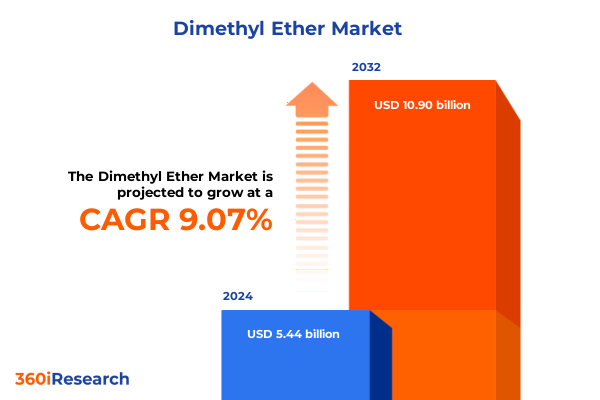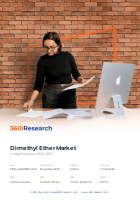The Dimethyl Ether Market size was estimated at USD 5.44 billion in 2024 and expected to reach USD 5.91 billion in 2025, at a CAGR of 9.07% to reach USD 10.90 billion by 2032.

Unveiling Dimethyl Ether’s Strategic Role in Advancing Sustainable Energy Solutions and Diversifying Chemical Feedstocks
Dimethyl ether represents a pivotal advancement in sustainable energy and chemical feedstocks. As a simple ether comprised of two methyl groups bound to an oxygen atom, it exhibits properties that uniquely position it for a range of industrial and environmental applications. Under standard conditions, dimethyl ether exists as a colorless gas that transforms into a liquid under mild pressure, mirroring the handling characteristics of liquefied petroleum gas. Its molecular structure yields a high cetane number, minimal particulate emissions, and near-zero sulfur content, making it an attractive candidate as a clean-burning fuel in compression ignition engines and gas turbines.
Navigating Transformative Technological and Policy Shifts Redefining Dimethyl Ether’s Trajectory Across Energy and Industrial Sectors
The dimethyl ether sector is experiencing a convergence of technological breakthroughs and policy initiatives that are reshaping its growth trajectory. Catalytic innovations, such as bifunctional systems enabling direct synthesis of DME from synthesis gas or CO₂ hydrogenation pathways, have demonstrated enhanced conversion efficiencies and streamlined production processes. These advancements reduce reliance on intermediate methanol dehydration steps and support power-to-liquid and closed carbon loop strategies, aligning with global decarbonization priorities.
Simultaneously, governments across multiple regions are embedding dimethyl ether within decarbonization frameworks and incentive programs. The inclusion of DME in emissions trading schemes and renewable fuel directives underscores its viability in achieving carbon pricing targets and clean fuel standards. Policy signals from the European Union, North America, and key Asian markets are fostering infrastructure development and pilot demonstrations, catalyzing wider industrial uptake.
Industry partnerships and demonstration projects further attest to this transformative phase. Major energy players have launched large-scale DME facilities and pilot fleets, while OEMs collaborate on engine conversions to validate performance and emissions benefits. As these synergistic advancements intersect, dimethyl ether is steadily transitioning from niche applications to a cornerstone of sustainable energy and chemical strategies.
Assessing the Cumulative Impact of United States Tariff Shifts in 2025 on Global Dimethyl Ether Supply Chains and Cost Structures
The United States instituted a baseline 10% reciprocal tariff on all imports effective April 2, 2025, followed by country-specific duties on select trade partners, targeting goods with significant bilateral imbalances. Although chemical products such as polyethylene and pharmaceuticals initially received exemptions, the overarching framework subjects most feedstocks, intermediates, and DME imports to additional ad valorem levies. In parallel, Section 232 and 301 investigations continue to loom over critical minerals and raw materials, underscoring the administration’s industrial policy tilt.
Unpacking Key Segmentation Insights Illuminating Dimethyl Ether Market Dynamics Across Production Technologies and Applications
Production and product formats in the dimethyl ether landscape are defined by two core technology streams and dual state offerings. On the technology front, biomass gasification competes with methanol dehydration processes, each presenting distinct capital and feedstock profiles. Meanwhile, the market’s gaseous and liquid forms cater to divergent storage and distribution infrastructures, influencing upstream investments and logistical frameworks.
Purity tiers further nuance the commercialization pathway, as high-purity grades support precision chemical syntheses while industrial-grade variants address bulk fuel and propellant roles. This segmentation underpins tailored product positioning, with quality specifications driving off-take agreements in aerosol propellant, chemical intermediate, power generation, and transportation fuel segments. Within power generation, off-grid deployments demand robust supply reliability, whereas stationary systems prioritize continuous operation profiles. Transportation applications, spanning aviation, marine, and road transport, call for engine compatibility and refueling ecosystem readiness.
Finally, end-use industries orchestrate distinct demand drivers. Chemical manufacturing leverages DME as a methylating agent and precursor for olefins, while power generation stakeholders emphasize DME’s operational cleanliness and efficiency. In the transportation domain, burgeoning mandates on emissions and fuel quality are accelerating trials and adoption of DME-powered fleets.
This comprehensive research report categorizes the Dimethyl Ether market into clearly defined segments, providing a detailed analysis of emerging trends and precise revenue forecasts to support strategic decision-making.
- Production Technology
- Product Type
- Purity
- Application
- End-Use Industry
Exploring Regional Dynamics Shaping Dimethyl Ether Adoption Across the Americas Europe Middle East Africa and Asia Pacific
In the Americas, robust natural gas availability and established petrochemical infrastructure favor conversion to dimethyl ether via synthesis gas routes. Supportive federal policies, coupled with state-level clean fuel standards, are catalyzing pilot projects for heavy-duty transport and off-grid power. Meanwhile, investment cycles in North America hinge on domestic gas pricing and the evolution of carbon credit schemes.
Across Europe, the Middle East, and Africa, climate directives and decarbonization targets underpin DME’s appeal as a low-emission alternative. The European Union’s renewable energy framework has recognized DME within advanced biofuel categories, prompting consortium-led initiatives for bio-derived feedstocks. In parts of the Middle East, leveraging stranded associated gas through gasification-to-DME pathways addresses flaring challenges while supporting export diversification. African markets, while nascent, are exploring DME for rural electrification and cooking fuel substitution.
Asia-Pacific remains the dominant region for DME demand, with China accounting for the lion’s share of global consumption driven by policy incentives and proven large-scale demonstration. Japan and South Korea actively pursue next-generation fuel strategies, executing government-backed demonstrations in transportation and residential heating. A growing network of public-private partnerships continues to advance infrastructure and streamline regulatory frameworks across the region.
This comprehensive research report examines key regions that drive the evolution of the Dimethyl Ether market, offering deep insights into regional trends, growth factors, and industry developments that are influencing market performance.
- Americas
- Europe, Middle East & Africa
- Asia-Pacific
Key Strategic Insights from Leading Companies Shaping the Future of Dimethyl Ether Through Partnerships Technology and Innovation
Leading chemical and energy companies are forging strategic alliances to secure feedstock supply and accelerate technology commercialization. Catalyst developers collaborate with engineering firms to optimize reactor designs for direct DME synthesis, while specialty chemical manufacturers integrate DME into methylation and olefins production platforms. Partnerships extend to technology licensors, where licensing agreements expedite deployment of single-step and two-step process technologies in emerging markets.
Major gas and utility players leverage their distribution networks to establish DME supply chains, transforming propane infrastructure for dual-fuel dispensing and retrofitted vehicle fleets. Simultaneously, equipment suppliers and OEMs concentrate on engine modification kits, injector technologies, and storage solutions to ensure seamless integration into existing power generation and transport systems.
Investment consortiums featuring industry leaders, government bodies, and research institutes are pooling resources for carbon-neutral DME initiatives. These consortiums facilitate demonstration projects, regulatory sandboxes, and cross-border knowledge exchange, laying the groundwork for scalable commercialization and convergence of policy, technology, and market acceptance.
This comprehensive research report delivers an in-depth overview of the principal market players in the Dimethyl Ether market, evaluating their market share, strategic initiatives, and competitive positioning to illuminate the factors shaping the competitive landscape.
- Air Liquide S.A.
- Akzo Nobel N.V.
- China Energy Investment Corporation Limited
- Fujian Lyondissolve Chemical Co., Ltd.
- Grillo-Werke AG
- Guangdong JOVO Group Co., Ltd.
- Jiutai Energy Group Co., Ltd.
- Korea Gas Corporation
- Mitsubishi Corporation
- Mitsubishi Gas Chemical Company, Inc.
- Nouryon B.V.
- Oberon Fuels, Inc.
- PCC SE
- Shell plc
- Sichuan Lutianhua Co., Ltd.
- The Chemours Company
- Topsoe A/S
- Toyo Engineering Corporation
- Zagros Petrochemical Company
Actionable Recommendations for Industry Leaders to Enhance Dimethyl Ether Supply Chain Resilience and Accelerate Sustainable Growth
Industry leaders should prioritize diversified feedstock strategies that integrate biomass gasification, power-to-DME, and conventional synthesis gas pathways to mitigate price volatility and regulatory risk. Strengthening partnerships across catalyst providers, engineering firms, and offtake customers will shorten development cycles and drive down production costs, unlocking broader market opportunities.
Engaging proactively with policymakers and regulatory agencies will ensure that DME secures its place in clean fuel standards and incentive frameworks. Companies can contribute technical expertise to carbon pricing discussions, demonstrating DME’s value proposition in emissions reduction and energy security.
Furthermore, investing in modular production units and flexible distribution infrastructure will enhance resilience against geopolitical shifts and supply chain disruptions. By adopting a phased approach to capacity expansion and leveraging strategic joint ventures, organizations can capture early mover advantages while adapting to evolving market signals.
Rigorous Research Methodology Underpinning Comprehensive Analysis of Dimethyl Ether Markets Technologies and Industry Trends
This analysis is grounded in a multi-tier research framework encompassing both primary and secondary data collection. Primary insights derive from expert interviews with producers, technology licensors, end-users, and policy analysts, offering firsthand perspectives on operational challenges and strategic priorities.
Secondary data sources include industry white papers, patent filings, regulatory filings, and peer-reviewed publications. These materials were systematically reviewed and cross-referenced to validate technological claims, policy impacts, and supply chain configurations.
Data triangulation techniques ensured consistency across qualitative and quantitative findings. An advisory panel of sector experts reviewed preliminary conclusions, providing critical feedback to refine scenario analyses and ensure robust, objective outcomes.
This section provides a structured overview of the report, outlining key chapters and topics covered for easy reference in our Dimethyl Ether market comprehensive research report.
- Preface
- Research Methodology
- Executive Summary
- Market Overview
- Market Insights
- Cumulative Impact of United States Tariffs 2025
- Cumulative Impact of Artificial Intelligence 2025
- Dimethyl Ether Market, by Production Technology
- Dimethyl Ether Market, by Product Type
- Dimethyl Ether Market, by Purity
- Dimethyl Ether Market, by Application
- Dimethyl Ether Market, by End-Use Industry
- Dimethyl Ether Market, by Region
- Dimethyl Ether Market, by Group
- Dimethyl Ether Market, by Country
- Competitive Landscape
- List of Figures [Total: 30]
- List of Tables [Total: 567 ]
Consolidating Key Findings on Dimethyl Ether’s Role in Decarbonization Energy Efficiency and Industrial Transformation
Dimethyl ether emerges as a versatile, low-emission solution that bridges energy and chemical applications, supporting decarbonization objectives and enhancing fuel security. Its adaptability-from renewable feedstocks to legacy fuel infrastructure-positions it uniquely at the nexus of environmental and industrial imperatives.
As policy landscapes tighten around carbon emissions and clean energy transitions accelerate, dimethyl ether stands ready to deliver tangible benefits across power generation, transport, and specialty chemical sectors. By synthesizing the latest technological, regulatory, and market developments, this analysis underscores DME’s strategic significance for stakeholders pursuing sustainable growth and competitive differentiation.
Empower Your Strategic Decisions Today by Securing the Comprehensive Dimethyl Ether Market Research Report with Ketan Rohom
Embark on an opportunity to equip your organization with strategic foresight and actionable intelligence on the dimethyl ether landscape. Partner with Ketan Rohom, Associate Director of Sales & Marketing at 360iResearch, to secure the definitive market research report that will inform critical investment decisions, technology roadmaps, and competitive positioning. Reach out today to gain immediate access to comprehensive analyses, expert insights, and an in-depth understanding of the forces shaping dimethyl ether’s present and future trajectory. Elevate your strategic decision-making by leveraging this tailored resource and accelerate your path to market leadership.

- How big is the Dimethyl Ether Market?
- What is the Dimethyl Ether Market growth?
- When do I get the report?
- In what format does this report get delivered to me?
- How long has 360iResearch been around?
- What if I have a question about your reports?
- Can I share this report with my team?
- Can I use your research in my presentation?




